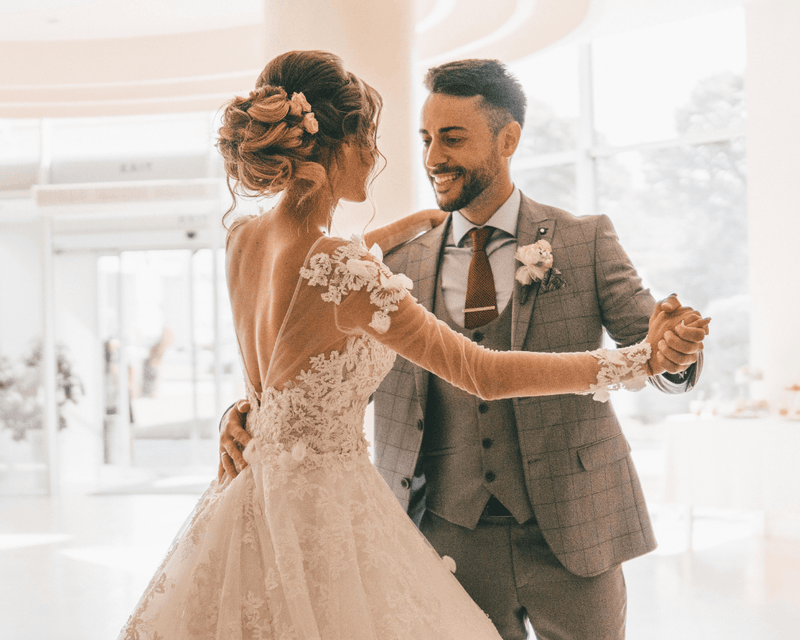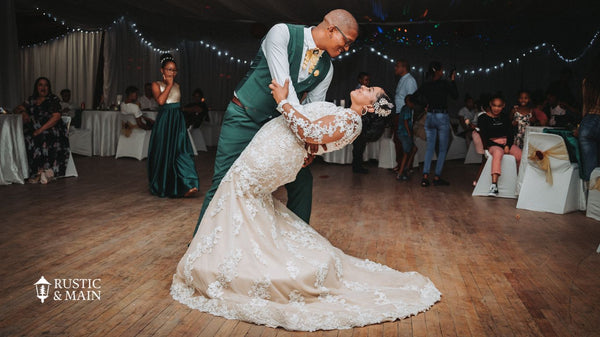What Is the First Dance Etiquette at a Wedding?
March 25 2021 – Mike Yarbrough

We love to delve into the history behind wedding traditions, especially commonplace customs where the meaning and origin can easily go overlooked. Weddings have so many associated customs and traditions but we don't always take the time (or have the time) to wonder about why we choose to partake in these traditions. For example, it's customary for the bride and groom to share the first dance at their wedding. But where did that tradition take root? Discover the origins of the first dance and the etiquette associated with this beautiful wedding tradition.
If you're planning on getting married soon, you might also be wondering about first dance etiquette. Some questions you may have could be:
- When are you supposed to dance?
- Who dances with who?
- When is the first dance at a wedding?
- Do you even need a first dance at your wedding?

The Origin of the First Dance Tradition
The tradition of a first dance goes back to 17th-century Europe. Formal balls were popular during this time, and it was customary for a guest of honor (typically the person of the highest social standing in attendance) to lead the first dance.
For example, if a member of the royal family was present, they would almost certainly have the first dance. The host or hostess would announce the opening of the ball. Then the first dance would begin, led by the guest or guests of honor.
This time was before the popularity of ballroom dancing. The dances of the time were long country dances like a line or parade. The first couple wouldn't be the only ones dancing throughout the first piece of music; rather they would lead the other couples down the set.

First Dance Etiquette
While the modern-day tradition of a first dance can be traced back to 17th-century Europe, it has changed plenty since then. As recently as the 1920s, it was considered good etiquette for the newlyweds to let their guests dance first. These days, the bride and groom usually share the first dance, often to a song they both have chosen specifically for that purpose. Once the first song is over, the evening can proceed in various ways.
Some brides and grooms invite all of the couples out onto the floor after the first dance has ended. If you want to go a more "traditional" route, there is a generally-agreed-upon etiquette when it comes to the ordering of the dances:
-
The bride and groom share the first dance.
-
The father of the bride then dances with the bride. The groom may also dance with the mother of the bride.
-
Next, the bride's mother and father dance together. The groom dances with his mother, and then the groom's parents dance together.
-
The dance floor then opens up to the bridesmaids and groomsmen. At many weddings, each groomsman dances with the bride, and the bridesmaids take turns dancing with the groom.
- After that, it's a free-for-all. Everybody out on the dance floor!

- For just a few songs, you pause the dance party and have an anniversary dance (otherwise known as a bouquet dance). The DJ clears the floor and brings out all the married couples in attendance. The emcee then begins to ask couples to take a seat, starting with people who have been married less than a year and going up from there. The last couple left dancing (the couple whose been married the longest) receives the bride’s bouquet. A bouquet dance is a sweet tradition to substitute for a bouquet toss, and it highlights all the amazing couples in your and your spouse’s lives.
- Post Cake Cutting Dance
- The cake cutting marks the end of the formal wedding proceeding. This is where the older guests retire and the younger guests get their second dancing wind. An upbeat song is a great way to get the dance floor energy up for the second half of the wedding reception.
- The Garter & Bouquet Toss Dance
- Near the end of the night, the bride traditionally tosses her bouquet to all the single girls at the wedding, and the groom tosses his new wife’s garter to all the single guys. The guy and girl who catch their corresponding objects are said to be the next people to get married (not necessarily to each other) and are supposed to take a turn around the dance floor together.
Many couples will enjoy the traditional lineup of wedding dances above, but some couples like to make their wedding dances all their own! Here are a few suggestions for those who want to dance to the beat of their own drum.

First Dance Alternatives
An increasing number of couples are choosing to have weddings that blend the traditional with the alternative. How you choose the first dance tradition can be part of that. Here are a few ways to put a different spin on the first dance:
-
Choose a unique (or unexpected) song for the first dance. Make it a number that says something about the bride and groom. You could swing dance to your favorite country tune, or headbang through a beloved metal song.
- Invite all the couples onto the dance floor at once. This option is great if you don't want to be in the spotlight or if you want to celebrate the togetherness of your family, friends, and community.
-
Do a surprise wedding mashup- This can be fun for couples! You start off with a typical slow dance and then suddenly transition to an upbeat song to go with the snazzy choreography you and your spouse have put together to wow your guests. It’s an unforgettable show for your wedding guests and a fun thing to work on with your partner before your big day. Plus, if you can’t get the choreography together in time, you already have a song picked out to slow dance to in a pinch.
-
Sing the first song. Not into dancing? Switch things up and have karaoke at your wedding reception. The bride and groom can have the honor of dueting on the first song.
- Have a Wedding Party Dance. Ask the bridal party and/or groomsmen out onto the dance floor for a wedding party dance. Bringing more people out on the dance floor can take a little pressure off the bride and groom. Some wedding parties even come up with a choreographed dance routine.


